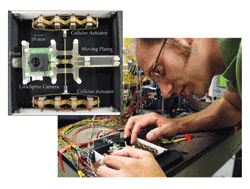Piezo ‘muscles’ let camera ape human eye movement
Using piezoelectric materials, researchers at the Georgia Institute of Technology’s George W. Woodruff School of Mechanical Engineering (www.me.gatech.edu) have replicated the muscle motion of the human eye to control camera systems in a way designed to improve the operation of robots. Assistant professor Jun Ueda, who leads the Bio-Robotics and Human Modeling Laboratory, and Ph.D. candidate Joshua Schultz suggest that their approach to camera movement could help make robotic tools safer and more effective for such tasks as MRI-guided surgery and robotic rehabilitation. Furthermore, the technique can help in research studies on human eye movement as well as in making video feeds from robots more intuitive.
Key to the new camera-motion control system is a piezoelectric cellular actuator that uses biologically inspired technology. “For a robot to be truly bioinspired, it should possess actuation, or motion generators, with properties in common with the musculature of biological organisms,” said Schultz. “The actuators developed in our lab embody many properties in common with biological muscle, especially a cellular structure.
While piezoelectric actuators have been used in numerous applications, the use of robust piezoelectric ceramic in robotics applications has been limited due to its minuscule displacement. The cellular actuator concept developed by the research team was inspired by biological muscle structure that connects many small actuator units in series or in parallel. “Each muscle-like actuator consists of a piezoelectric material and a nested hierarchical set of strain-amplifying mechanisms,” explained Ueda. “Unlike traditional actuators, piezoelectric cellular actuators are governed by the working principles of muscles namely, motion results by discretely activating, or recruiting, sets of active fibers, called motor units. Motor units are linked by flexible tissue, which serves a twofold function. It combines the action potential of each motor unit, and presents a compliant interface with the world, which is critical in unstructured environments.”
To demonstrate their design principals, the team developed a lightweight, high-speed system based on a single-degree-of-freedom camera positioner that uses less energy than traditional camera positioning mechanisms and is more flexible. The camera positioner uses a contractile ceramic driven by 16 amplified piezoelectric stacks per side to generate motion. The use of multiple stacks addressed the need for more layers of amplification. The units were placed inside a rhomboidal mechanism (see Fig. 1 ).

Fig. 1: Georgia Tech Ph.D. Candidate Joshua Schultz makes some final adjustments to the camera-positioning mechanism of the research device seen in the insert. The four sets of four piezoelectronic actuators seen at both the top and bottom of the inset are used to provide an eye-muscle-like structure to move the camera. (Main photo: Billy Gallagher; inset: Joshua Schultz)
The work offers an analysis of the force-displacement tradeoffs involved in the actuator design and shows how to find geometry that meets the requirement of the camera positioner, said Schultz. The mathematical concepts can be used to predict the performance, as well as select the required geometry, of nested structures. The mechanisms can scale up the displacement of piezoelectric stacks to the range of the ocular positioning system. In the past, the piezoelectric stacks available for this purpose have been too small.
“Our research shows a two-port network model that describes compliant strain amplification mechanisms that increase the stroke length of the stacks,” said Schultz. “The goal of scaling up piezoelectric ceramic stacks holds great potential to more accurately replicate human eye motion than previous actuators,” he noted.
Future research by the team will continue to focus on development of a design framework for highly integrated robotic systems. It will involve implantation of the technology on a multi-degree-of-freedom device, applying open- and closed-loop control algorithms for positioning, and analysis of co-contraction phenomena. “Eventually, the actuators we are developing will be used to capture the kinematics and performance of the human eye,” said Schultz.
“Robustness against uncertainty of model and environment is crucial for robots physically interacting with humans and environments,” said Ueda. “Successful integration relies on the coordinated design of control, structure, actuators and sensors by considering the dynamic interaction among them.” For further information, contact Jun Ueda,
, 404-385-3900.
Richard Comerford
Advertisement
Learn more about Georgia Institute of Technolog





